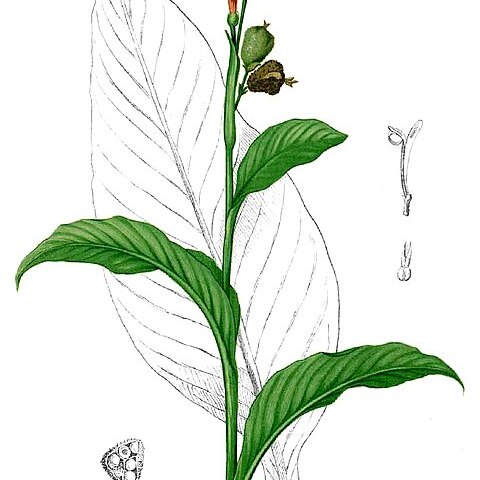Large perennial, usually rhizomatous, glabrous herbs, with unbranched aerial stems. Leaves alternate, with open eligulate sheaths. Inflorescence terminal, spicate or branched, each branch with a 2-keeled bract at base, the flowers 1 or 2 together, each flower or pair subtended by a bract and sometimes bracteoles. Flowers showy, zygomorphic, bisexual. Sepals 3, free, persistent. Petals 3, often unequal, usually basally connate and adnate to androecium and style to form tube. Stamen 1; filament usually petaloid, enfolding style in bud; anther attached to margin of filament, 1-locular but sometimes appearing 2-locular; staminodes 1-4, rarely 5, petaloid; inner staminode usually curled and forming a staminodial lip or labellum; outer staminodes, if present, usually larger and erect. Style flat; stigma terminal; ovary inferior, 3-locular, densely papillose; locules with numerous anatropous ovules. Fruit a capsule, loculicidally 3-valved, rarely indehiscent.
Herbs arising from horizontal variously thickened rhizomes. Leafy shoots erect. Leaves spirally arranged, with open sheaths; ligule absent. Inflorescence terminal, many-flowered, bracteate, either a simple spike or a pseudo-spike made up of 2-flowered subunits. Flowers asymmetric. Perianth 6-partite, in 2 whorls. Outer whorl with 3 ovate segments. Inner whorl of 3 narrowly oblong segments, longer than the members of the outer whorl. Androecium largely petaloid, usually with one member (the labellum) much larger than the others. Anther with a single fertile theca on one side of a petaloid member. Style fleshy, free or connate with the petaloid part of the stamen and staminodes to form a tube. Ovary inferior, 3-locular; surface spiny-fimbriate or verrucose; ovules numerous, axillary. Fruit capsular, loculicidally dehiscent (often tardily so); seeds globose, smooth, very hard
Herbs perennial. Stems erect, robust. Rhizomes tuberous. Leaves alternate, spirally arranged, large, veins pinnate and parallel, base sheathing. Inflorescence a terminal raceme or panicle of showy, 1-or 2-flowered cincinni. Flowers bisexual, asymmetric, mostly large. Sepals 3, green, free, persistent. Corolla lobes 3, green or colored, basally connate into a tube and adnate to staminodes. Staminodes and stamen in 2 whorls: outer whorl with (2 or)3 conspicuous, petaloid staminodes, usually red or yellow; inner whorl with a reflexed staminode (labellum), narrower than outer staminodes, and a fertile stamen; filament petaloid; anther 1-loculed, adnate to apical margin of filament. Ovary inferior, 3-loculed; ovules numerous per locule; placentation axile. Style petaloid. Fruit a capsule, 3-valved, usually warty. Seeds many, globose; endosperm copious; embryo straight.
Stamens petaloid, 3 outer sterile, imbricate, 2 inner more or less connate, 1 free; anther solitary, 1-locular, adnate to the side of the petaloid portion
Flowers racemose or paniculate, bracteate, zygomorphic, bisexual, mostly large and brightly coloured
Petals 3, connate at the base and adnate to the staminal column
Perianth double, the outer calyx-like, the inner corolla-like
Leaves large, broad, pinnately nerved, with a distinct midrib
Ovary inferior, 3-locular; ovules numerous, axile
Seeds many, rounded, with very hard endosperm
Fruit a capsule, pericarp often warted
Tall leafy perennial rhizomatous herbs
Sepals 3, imbricate, free, herbaceous

